Harpoon Brewery! A pillar of Boston brewing, to be spoken of both in hushed, reverent tones, and bellowed from the rooftops in joy with several pints coursing through your veins. The first and fiercest of the Boston brew businesses. Alongside the famed Samuel Adams Brewery, they helped to build the craft beer industry in this state (well, commonwealth).
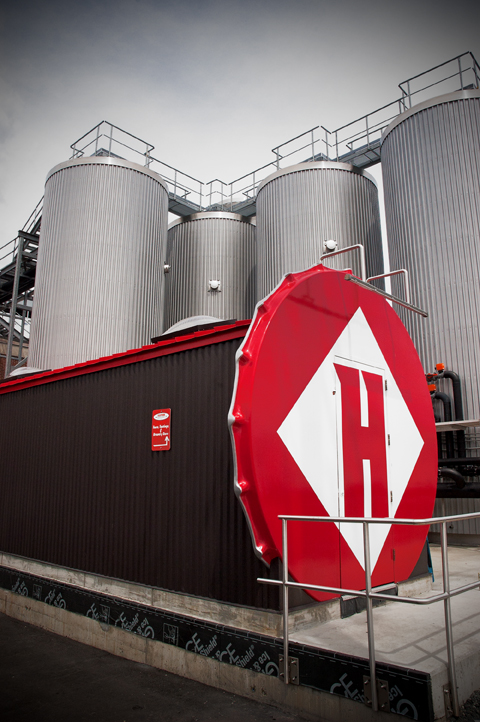 Like any true Bostonian/ Massachusettserite/ New Englander, I’ve been to Harpoon for the tours and tastings several times. Lady Friend, despite living in MA for a number of years, had not. She even parks across the street from the brewery and works about a block away. Jeezum Crow! (Thanks for getting that one stuck in my head, LB).
Like any true Bostonian/ Massachusettserite/ New Englander, I’ve been to Harpoon for the tours and tastings several times. Lady Friend, despite living in MA for a number of years, had not. She even parks across the street from the brewery and works about a block away. Jeezum Crow! (Thanks for getting that one stuck in my head, LB).
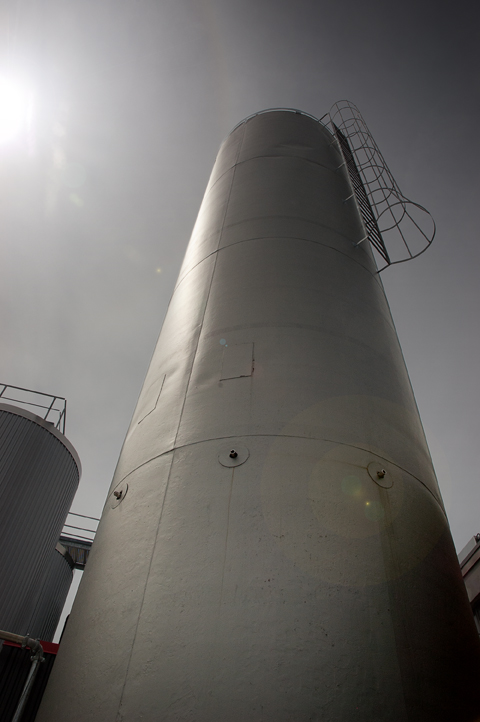 So we went on the tour. She was not given the option. It was a requirement. They do tours and tastings every Saturday 10:30a-5p, and Sunday 11:30a-3p. It’s $5 for an hour tour, including a 20 minute or so tasting session, tasting glass and handy little pamphlet explaining the myriad of tasty drinky drinks. Get there earlier rather than later, as tours tend to sell out. We got there at noon for the 12:30 slot, and had about 25 other people in our group. When we finished, the 1:30 tour only had about seven or eight people lined up. Oh well.
So we went on the tour. She was not given the option. It was a requirement. They do tours and tastings every Saturday 10:30a-5p, and Sunday 11:30a-3p. It’s $5 for an hour tour, including a 20 minute or so tasting session, tasting glass and handy little pamphlet explaining the myriad of tasty drinky drinks. Get there earlier rather than later, as tours tend to sell out. We got there at noon for the 12:30 slot, and had about 25 other people in our group. When we finished, the 1:30 tour only had about seven or eight people lined up. Oh well.
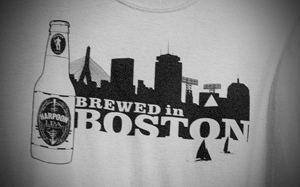 You go around the right side of the building following the tour/ brewery store signs. $5 later, you’re headed up the stairs to the retail area. Harpoon also goes a little nutty with merchandise, just not to the extent of Magic Hat. Lots of tshirts, sweatshirts, glassware and, of course, beer begging you to adopt it like a sad little puppy at the animal shelter. 22oz bombers of the
You go around the right side of the building following the tour/ brewery store signs. $5 later, you’re headed up the stairs to the retail area. Harpoon also goes a little nutty with merchandise, just not to the extent of Magic Hat. Lots of tshirts, sweatshirts, glassware and, of course, beer begging you to adopt it like a sad little puppy at the animal shelter. 22oz bombers of the 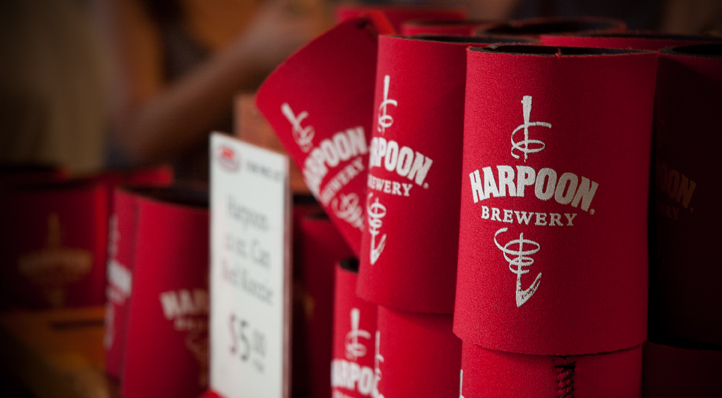 flagship brew, Harpoon IPA, will only set you back $3, and six packs are $8. That’s about the cheapest you’ll find Harpoon for, and it’s worth it. We milled around the retail/ bar area while a previous group did their tasting. Then it was zero hour; through the doors, no looking back.
flagship brew, Harpoon IPA, will only set you back $3, and six packs are $8. That’s about the cheapest you’ll find Harpoon for, and it’s worth it. We milled around the retail/ bar area while a previous group did their tasting. Then it was zero hour; through the doors, no looking back.

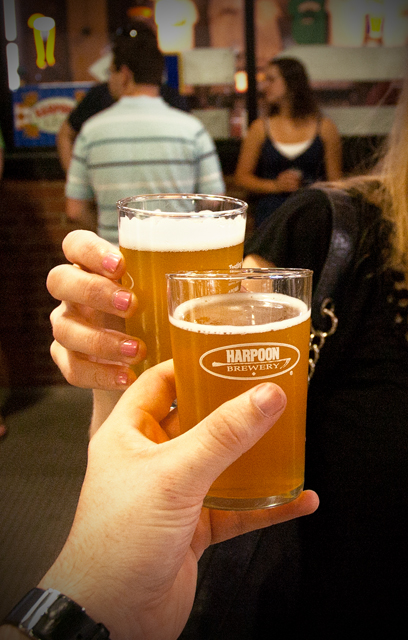 Into the brewery! They hand you a tasting glass and pour your first beer once you enter the brewing floor. Ours was the UFO Hefeweizen, an unfiltered wheat beer (UFO stands for UnFiltered Offering, and is one of their product lines). Then the info: beer is made from hops, barley, blah blah blah. Standard speech, though our tour guide, Joe, had it down cold. Earlier, in the bar area, Lady Friend and I had overheard a woman ask one of the female staff what the Oktoberfest beer was, and the girl stammered, stuttered, and passed the question off to another tour guide. Pretty simple question that she should have been able to answer. Even Lady Friend caught the faux pas, and we both rolled our eyes. Pretty sure you should be familiar with one of the most popular products if you’re going to be giving the tours.
Into the brewery! They hand you a tasting glass and pour your first beer once you enter the brewing floor. Ours was the UFO Hefeweizen, an unfiltered wheat beer (UFO stands for UnFiltered Offering, and is one of their product lines). Then the info: beer is made from hops, barley, blah blah blah. Standard speech, though our tour guide, Joe, had it down cold. Earlier, in the bar area, Lady Friend and I had overheard a woman ask one of the female staff what the Oktoberfest beer was, and the girl stammered, stuttered, and passed the question off to another tour guide. Pretty simple question that she should have been able to answer. Even Lady Friend caught the faux pas, and we both rolled our eyes. Pretty sure you should be familiar with one of the most popular products if you’re going to be giving the tours.
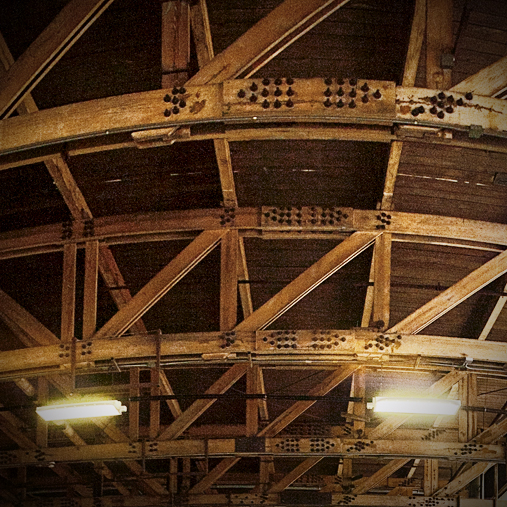 Items of note about Harpoon: they are located in an old Navy building, which had gigantic wooden beams and was some sort of “battleship hangar.” That’s what we were told. I’m sure it had something to do with the war effort back in the ’40s, as the whole area was previously part of a series of military buildings. Allegedly, the building is bombproof. Not a bad place to hide out when the Jerries are dropping Hun high-fives on your noggin.
Items of note about Harpoon: they are located in an old Navy building, which had gigantic wooden beams and was some sort of “battleship hangar.” That’s what we were told. I’m sure it had something to do with the war effort back in the ’40s, as the whole area was previously part of a series of military buildings. Allegedly, the building is bombproof. Not a bad place to hide out when the Jerries are dropping Hun high-fives on your noggin.
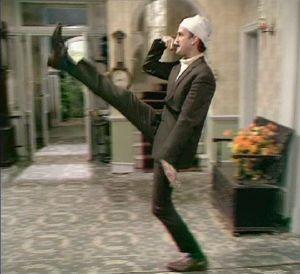
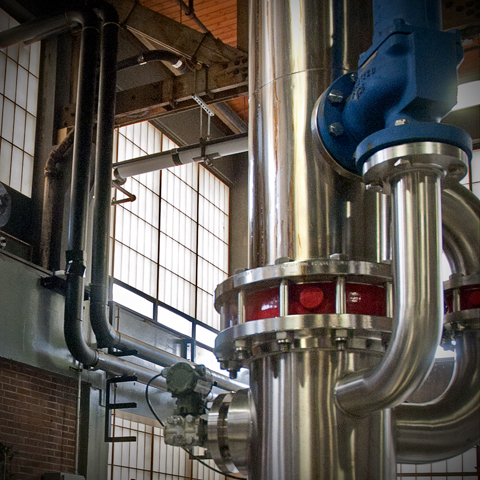 Like most other breweries, Harpoon sells its spent mash grain as livestock feed. A Harpoon Fun Fact: because the mash contains wild yeast, it continues to ferment before it reaches the moo cows, piggly-wigglies, and whatever other miscellaneous Green Acres type critters it’s destined for. Because of this, the mash may reach levels of 5%-9% abv before getting gobbled up, making some very happy beasties.
Like most other breweries, Harpoon sells its spent mash grain as livestock feed. A Harpoon Fun Fact: because the mash contains wild yeast, it continues to ferment before it reaches the moo cows, piggly-wigglies, and whatever other miscellaneous Green Acres type critters it’s destined for. Because of this, the mash may reach levels of 5%-9% abv before getting gobbled up, making some very happy beasties.
Harpoon uses pressurized brew tuns, indicated by the red band on the column, and the extra bolts holding the contraption together. This allows for a much quicker boil, which means a faster rotation of batches through the tun. Faster turnaround = more beer. Yay.
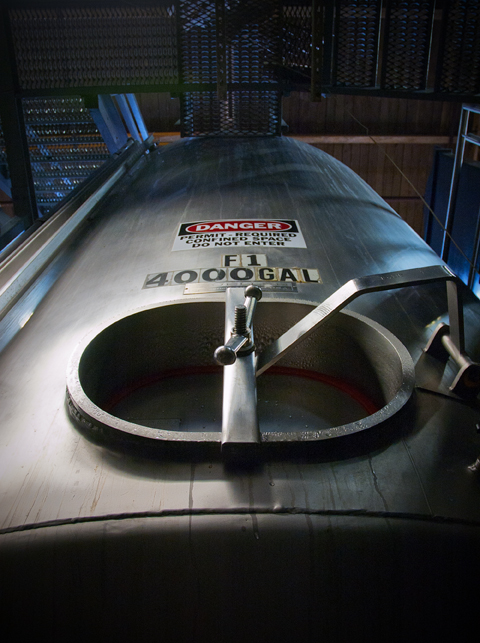
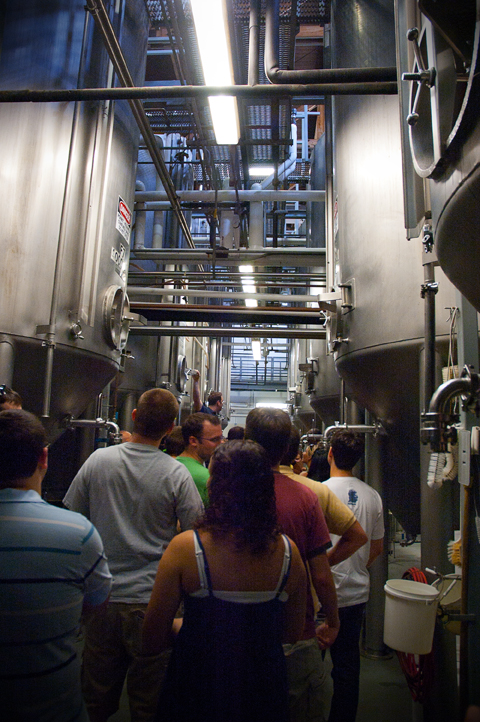 Ok. Down the stairs. This brings you in between the big fermentation tanks, where the beer sits and gets all alcoholly. Yum. The beer sits in there for a couple of weeks, as the yeast creates alcohol and carbonation in the beer. Conditioning at Harpoon only creates about 30% of the carbonation needed, and forced carbonation is added later. After the fermentation, the beer is conditioned, filtered, carbonated and bottled. We were given a taste of the IPA fresh from the tank, though the tap had to be sterilized with a butane torch first. Otherwise, bacteria on the tap could find its way into the tank and potentially ruin about 4,000 gallons of beer. Eep. So, a couple seconds of flame kills anything bad on the spigot, and then the pitchers started a-filling.
Ok. Down the stairs. This brings you in between the big fermentation tanks, where the beer sits and gets all alcoholly. Yum. The beer sits in there for a couple of weeks, as the yeast creates alcohol and carbonation in the beer. Conditioning at Harpoon only creates about 30% of the carbonation needed, and forced carbonation is added later. After the fermentation, the beer is conditioned, filtered, carbonated and bottled. We were given a taste of the IPA fresh from the tank, though the tap had to be sterilized with a butane torch first. Otherwise, bacteria on the tap could find its way into the tank and potentially ruin about 4,000 gallons of beer. Eep. So, a couple seconds of flame kills anything bad on the spigot, and then the pitchers started a-filling.
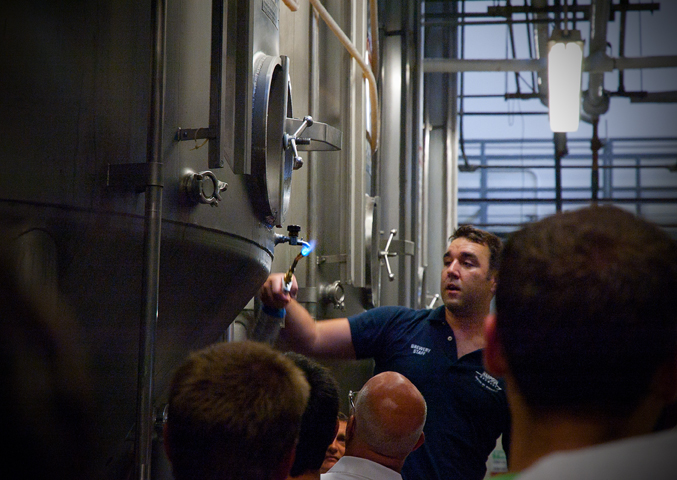
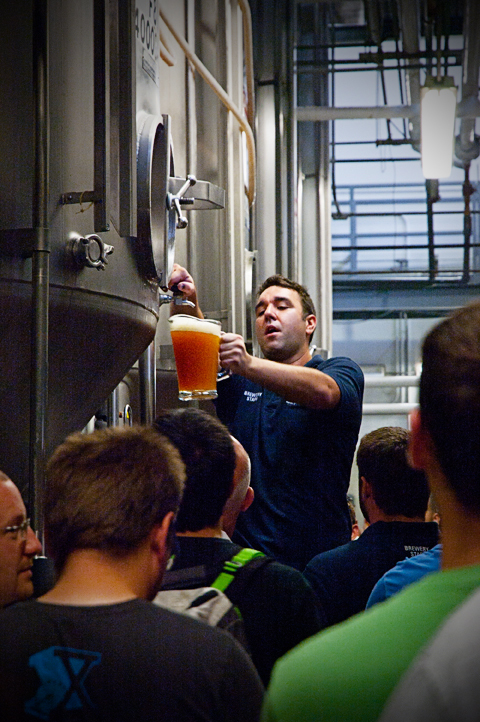
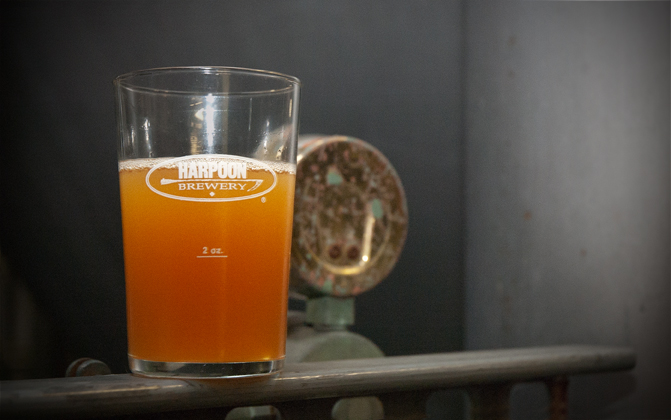 The IPA straight from the tank was tasty. The freshest beer you’ll ever have. It was rather flat and smooth, due to about 70% of the “normal” carbonation not being present. Tasted sweet, with some nice bitter hop, but still a tad undeveloped. Doesn’t have the full range that the finished product would. It was also cloudy, as it was unfilitered. A little yeast doesn’t hurt, and the tour went onwards into the bottling area. Their bottling setup runs at 125 bottles per minute. Yikes. From there it was into the warehouse, which had about 25,000 cases of beer sitting around, waiting for me to drink it (they can store up to 55,000 cases if needed). Harpoon’s production is targeted for 150,000 barrels of beer this year, though they expect to surpass that.
The IPA straight from the tank was tasty. The freshest beer you’ll ever have. It was rather flat and smooth, due to about 70% of the “normal” carbonation not being present. Tasted sweet, with some nice bitter hop, but still a tad undeveloped. Doesn’t have the full range that the finished product would. It was also cloudy, as it was unfilitered. A little yeast doesn’t hurt, and the tour went onwards into the bottling area. Their bottling setup runs at 125 bottles per minute. Yikes. From there it was into the warehouse, which had about 25,000 cases of beer sitting around, waiting for me to drink it (they can store up to 55,000 cases if needed). Harpoon’s production is targeted for 150,000 barrels of beer this year, though they expect to surpass that.
 While milling about the cases upon cases of brews, we heard the origins of Harpoon. It was a brewery born from frustration, as the two owners, Rich and Dan, couldn’t find the beer they wanted. That seems to be a common story among brewery owners; they can’t fine the beer they want so they make it themselves. Rich and Dan were recent graduates of Harvard Business School, and went on a European backpacking tour. Naturally, they wandered into quite a few beverage-dispensing establishments, and acquired a taste for proper ales, which they couldn’t find back in the States. So they decided to make their own. Allegedly, the business model for what would become Harpoon Brewing Company was a project for one of their classes while at Harvard Business. So, they applied for, and were granted, the first craft brewing license (seriously, number 01) in Massachusetts on June 3, 1987.
While milling about the cases upon cases of brews, we heard the origins of Harpoon. It was a brewery born from frustration, as the two owners, Rich and Dan, couldn’t find the beer they wanted. That seems to be a common story among brewery owners; they can’t fine the beer they want so they make it themselves. Rich and Dan were recent graduates of Harvard Business School, and went on a European backpacking tour. Naturally, they wandered into quite a few beverage-dispensing establishments, and acquired a taste for proper ales, which they couldn’t find back in the States. So they decided to make their own. Allegedly, the business model for what would become Harpoon Brewing Company was a project for one of their classes while at Harvard Business. So, they applied for, and were granted, the first craft brewing license (seriously, number 01) in Massachusetts on June 3, 1987.
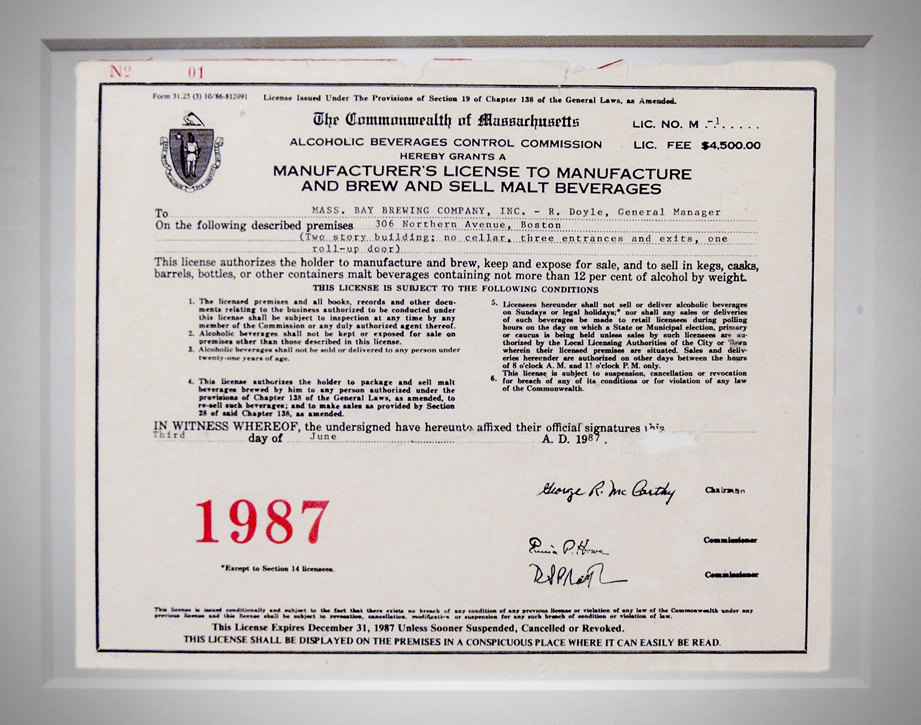
They figure everyone will see it after consuming several beer samples.
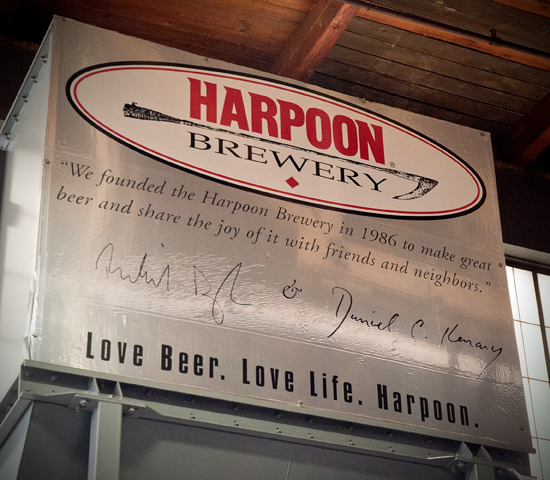 On the way back to the brewery store, where the tasting area is located, I asked tour guide Joe a few questions about the farmer-brewer license. He chuckled, and replied that yes, Harpoon is operating under farmer-brewer status, and that the 50% threshold requirement was simply not possible to uphold. That whole kerffufle is thankfully on it’s way to resolution, though the details have yet to be released. He also noted that Massachusetts doesn’t grow enough hops for Harpoon’s use alone, never mind any other breweries in the
On the way back to the brewery store, where the tasting area is located, I asked tour guide Joe a few questions about the farmer-brewer license. He chuckled, and replied that yes, Harpoon is operating under farmer-brewer status, and that the 50% threshold requirement was simply not possible to uphold. That whole kerffufle is thankfully on it’s way to resolution, though the details have yet to be released. He also noted that Massachusetts doesn’t grow enough hops for Harpoon’s use alone, never mind any other breweries in the state commonwealth.
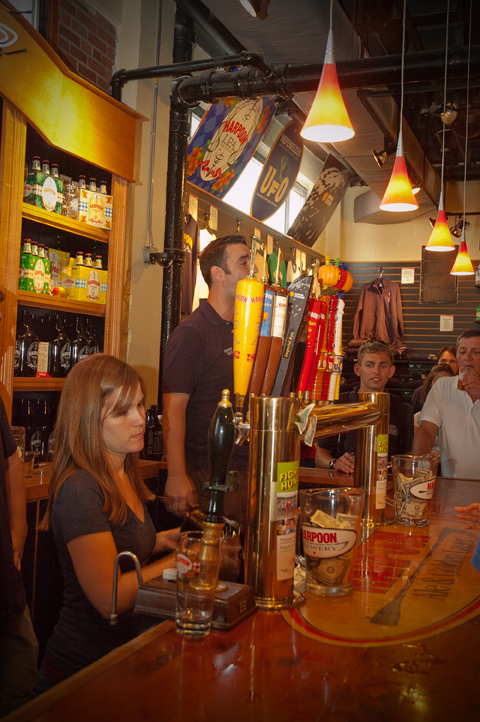 The tasting is a bit of a free-for-all. There is a bar set up in the midst of the retail area, and you belly up to sample the finished IPA first so you can compare and contrast to the newborn version straight from the tank. The IPA is their flagship brew, using five varieties of hop, and first produced in 1993 as a summer seasonal. When it was taken off the line to start the Oktoberfest, they received quite a number of strongly-worded complaints (back in the days of non-electronic mail), and brought the IPA back full-time due to the demand. Today, the IPA accounts for 65% of Harpoon’s sales, and they consider it a “gateway IPA,” one that will hopefully set you along the road to becoming a hop-head.
The tasting is a bit of a free-for-all. There is a bar set up in the midst of the retail area, and you belly up to sample the finished IPA first so you can compare and contrast to the newborn version straight from the tank. The IPA is their flagship brew, using five varieties of hop, and first produced in 1993 as a summer seasonal. When it was taken off the line to start the Oktoberfest, they received quite a number of strongly-worded complaints (back in the days of non-electronic mail), and brought the IPA back full-time due to the demand. Today, the IPA accounts for 65% of Harpoon’s sales, and they consider it a “gateway IPA,” one that will hopefully set you along the road to becoming a hop-head.
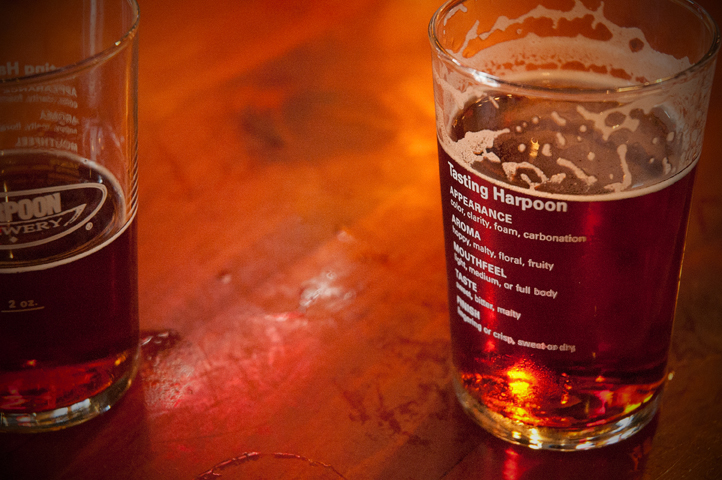
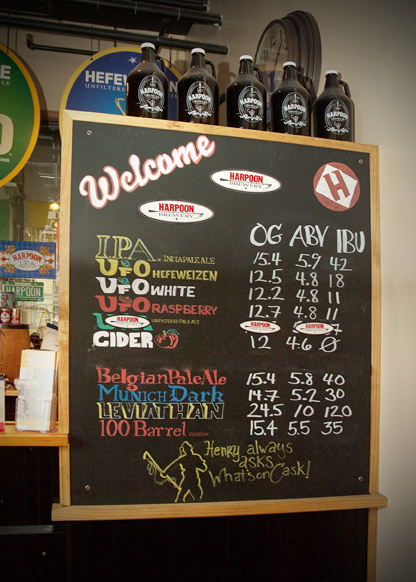 After the IPA, you are free to choose from about 10 of Harpoon’s other offerings, until time runs out and they kick you to the curb making room for the next tour coming through. I wouldn’t pound these beers, as some of them (notably the Leviathan series) clock in around 10% abv. The Harpoon sobriety test is “If you can’t pronounce ‘Leviathan,’ you’re cut off.” A pro tip: you want to aim for the harder-to-find varieties on your tasting. Ignore the UFO and Cider, and snag any of the 100-barrel series (we scored the Island Creek Oyster Stout, which contains 200 shucked oysters per brew, giving a smokey flavor from the extracted minerals. Overheard quote: “The Oyster is smooth as hell! Oh yeah!”). You’ll also want to zero in on the Leviathan series, which are the big boys. I managed a taste of the Imperial Rye (fruity, strawberry sweet nose. Syrupy mouthfeel, with a sour start, followed by a wash of fruit. Smooth and delicious) and the Imperial IPA, which is deliciously balanced, as the malt sweetness adeptly cuts through the hop punch. It’s excellent.
After the IPA, you are free to choose from about 10 of Harpoon’s other offerings, until time runs out and they kick you to the curb making room for the next tour coming through. I wouldn’t pound these beers, as some of them (notably the Leviathan series) clock in around 10% abv. The Harpoon sobriety test is “If you can’t pronounce ‘Leviathan,’ you’re cut off.” A pro tip: you want to aim for the harder-to-find varieties on your tasting. Ignore the UFO and Cider, and snag any of the 100-barrel series (we scored the Island Creek Oyster Stout, which contains 200 shucked oysters per brew, giving a smokey flavor from the extracted minerals. Overheard quote: “The Oyster is smooth as hell! Oh yeah!”). You’ll also want to zero in on the Leviathan series, which are the big boys. I managed a taste of the Imperial Rye (fruity, strawberry sweet nose. Syrupy mouthfeel, with a sour start, followed by a wash of fruit. Smooth and delicious) and the Imperial IPA, which is deliciously balanced, as the malt sweetness adeptly cuts through the hop punch. It’s excellent.
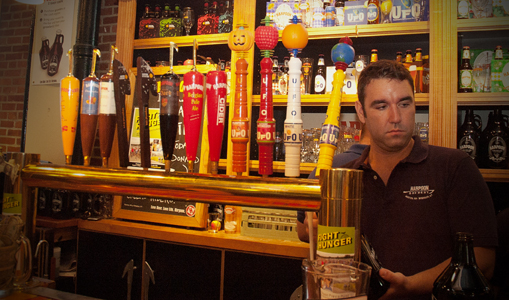
So. Harpoon is amazing. Sam Adams gets a lot of the tourist attention in Boston, but locals know that Harpoon is the real deal. Don’t get me wrong; I love Sam, but their Latitude 48 IPA isn’t even in the same ballpark as Harpoon’s brew. Harpoon is also the largest brewery in Boston, as Sam Adams runs experimental brews out of their Jamaica Plain location, with their primary brewery located in Pennsylvania. True, Harpoon does also have a Windsor, Vermont, facility, but they still do a very major portion of their production in Boston. Want to find out where that bottle you’re holding was brewed? Check out the “Best By” datestamp. If the “B’s” are capitalized, as in “Best By” it was Brewed in Boston. All caps? That was made in Vermont.
It’s official Boston Beer.
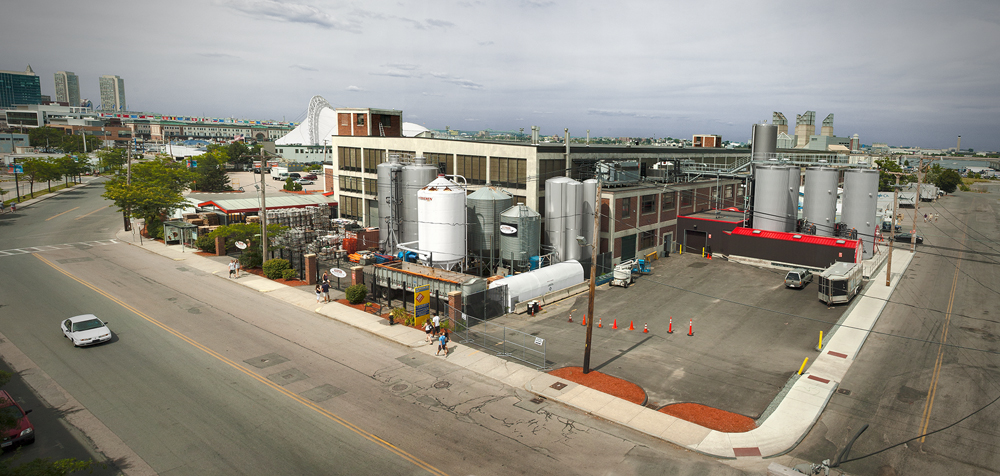
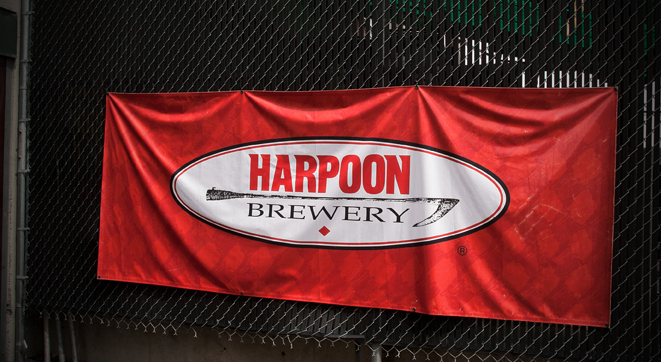





Woo-hoo! Can’t wait for an encore visit this weekend. It’ll be my first visit to a Boston based brewery. Consider my appetite (and pants) whetted.